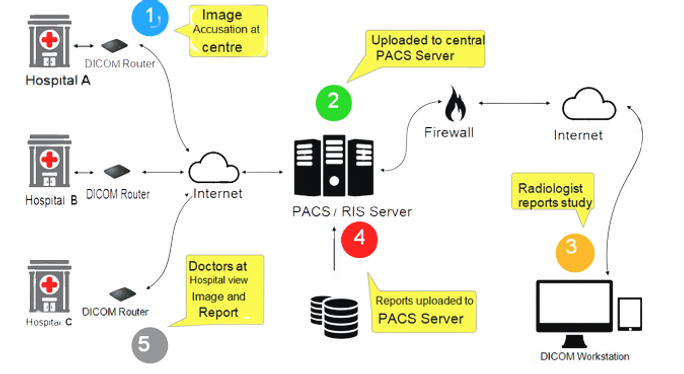Remote Work Best Practices for Radiologists
As the healthcare landscape continues to evolve, many radiologists are finding themselves working remotely. This shift to home-based practice, particularly within the context of teleradiology reporting services, presents unique challenges and opportunities. For radiologists, adopting best practices in ergonomics and technology setup is crucial to maintain productivity and ensure high-quality patient care. In this blog, we’ll explore essential tips for radiologists working from home, discuss the benefits of teleradiology, and how it serves diagnostic centers, hospitals, and medical organizations.
Table of Contents
ToggleCan Radiologists Work from Home?
Absolutely! Radiologists can effectively work from home, primarily through teleradiology reporting services. This model enables them to receive, analyze, and interpret medical images remotely. With the right technology, equipment, and security measures in place, radiologists can provide timely and accurate diagnoses from the comfort of their home offices. This flexibility not only improves work-life balance but also allows radiologists to cater to facilities in diverse locations, expanding their reach and expertise.
The Role of Radiologists in Teleradiology
Radiologists play a pivotal role in diagnosing and treating patients through the analysis of medical images. In a teleradiology reporting service, radiologists receive and interpret images remotely, allowing for quicker diagnoses and consultations. This model not only enhances workflow efficiency for diagnostic centers and hospitals but also expands access to expert radiology services, particularly in underserved areas.
Benefits of Teleradiology for Radiologists
Flexibility: Working from home allows radiologists to manage their time more effectively, balancing work and personal life.
Increased Opportunities: Teleradiology opens up job opportunities beyond geographical boundaries, enabling radiologists to collaborate with diverse healthcare organizations.
Continuing Education: Remote work can provide more time for professional development and continuing education through online courses and resources.
Enhanced Work-Life Balance: Reduced commuting time and the ability to customize your work environment can lead to a healthier work-life balance.
Radiology Remote Jobs: Navigating New Career Paths
The shift to remote work in the radiology field has opened up a variety of exciting career opportunities for radiologists. As healthcare facilities increasingly adopt teleradiology services, remote jobs have become more prevalent, allowing radiologists to work from home while continuing to provide vital diagnostic services. Here’s an overview of what to expect in the realm of remote radiology jobs.
Types of Remote Radiology Positions
Tele-Radiologist: This is the most common remote role, where radiologists interpret images, prepare reports, and communicate findings to referring physicians from a remote location. Flexibility in work hours is often a significant perk of this position.
On-Demand Radiologist: Many teleradiology companies offer on-demand services, allowing radiologists to pick up cases as their schedules permit. This model suits those seeking a more flexible work-life balance, enabling them to work as much or as little as they desire.
Radiology Quality Assurance Reviewer: In this role, radiologists review images and reports produced by other radiologists to ensure quality standards are met. This position is crucial for maintaining high-quality patient care and is often conducted remotely.
Educational and Training Roles: With the rise of telehealth, some radiologists are taking on roles that involve training and educating other healthcare professionals on teleradiology practices and technology.
Benefits of Remote Radiology Jobs
Flexibility: Remote positions allow radiologists to create their own schedules, making it easier to balance professional responsibilities with personal commitments.
Wider Job Market: Radiologists are no longer limited to job opportunities in their immediate geographical area. They can apply for positions across the country or internationally, broadening their career prospects.
Reduced Commuting Stress: Working from home eliminates the time and stress associated with daily commutes, allowing for a more efficient use of time.
Access to Diverse Cases: Remote work can provide exposure to a broader range of cases, as radiologists may work with various healthcare facilities that have different patient populations and imaging needs.
The Impact on Clients: Diagnostic Centers, Hospitals, and Medical Organizations
Teleradiology reporting services significantly benefit diagnostic centers, hospitals, and medical organizations by:
Reducing Wait Times: Faster reporting leads to quicker diagnosis and treatment decisions, enhancing patient care.
Access to Specialists: Facilities can access a broader network of radiologists, ensuring that patients receive the best possible expertise regardless of location.
Cost-Effective Solutions: Teleradiology can reduce operational costs associated with staffing and equipment for onsite radiology services.
Improved Patient Outcomes: With timely reports and access to specialists, patient outcomes can improve, leading to higher satisfaction rates.

Conclusion
As the demand for teleradiology reporting services continues to grow, it is essential for radiologists to adopt best practices for remote work. By focusing on ergonomics and optimizing technology setups, radiologists can enhance their productivity and maintain high standards of patient care. The ability to work from home not only supports greater flexibility but also opens doors to new professional opportunities. Embracing these changes can lead to a more efficient and satisfying work experience, ultimately benefiting patients and healthcare organizations alike.
